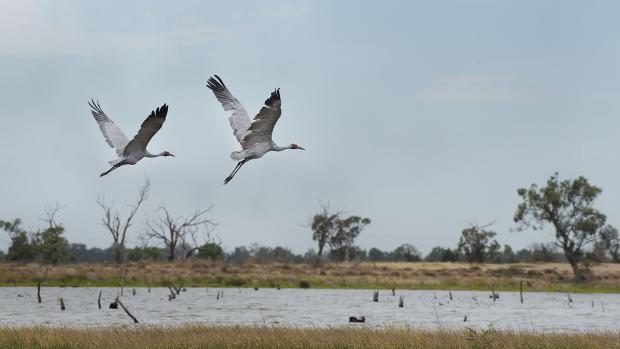Loading
A refuge for dry times

With all the focus rightly on the state of water quality and the health of fish across the northern Murray-Darling Basin, it can be easy to miss the important work being done to protect other important Basin species closer to home.
In the past three decades, bird numbers across the entire Basin have declined by more than 70 per cent, as a changed landscape, introduced predators and climate change take their toll.
And with the New South Wales and Gippsland drought coupled with dry conditions in northern Victoria, times continue to be tough for birds seeking feeding and breeding grounds.
The North Central Catchment Management Authority (CMA) delivers water for the environment to a range of wetlands in the state’s north, including the Loddon Murray Wetlands that are part of the internationally significant Kerang Lakes area.
“These wetlands are recovering well from the Millennium Drought and the floods that followed, and they have become a real refuge for both native and migratory birds,” North Central CMA Environmental Flows Project Manager Darren White said.
“Managing them with fluctuating water levels over the years means they are productive and attract birds of all kinds, including those that like high and low levels of water.
“We know these wetlands were home to a lot of birds coming down from NSW over the spring breeding season, and it’s important they remain healthy to help the new generation of birds thrive and survive.
“We have seen birds such as the Endangered Australasian bittern and brolga breeding and feeding in these wetlands.”
The North Central CMA will manage a series of small flows to five Loddon Murray Wetlands in the coming weeks – Lake Murphy, Johnson Swamp, the Wirra-Lo Wetland Complex, Round Lake and Lake Elizabeth.
“The flows will mostly be top-ups or water to prime the wetland in preparation for spring. At Lake Elizabeth and Round Lake the water will be delivered to manage salinity levels for the Endangered small-bodied Murray hardyhead fish.”
Up to 5.1 gigalitres will be delivered in total to all wetlands.\
“It’s important that wetlands receive water, when possible, during dry conditions,” Mr White said.
“Many of the state’s rivers, floodplains and wetlands constantly experience an artificial drought because of river regulation and population growth.
“This means that even when it is wet, they get less water than they would have naturally, as water is held back and stored, and up to half of it is removed for farms, towns and businesses.
“This impact is even greater when conditions are dry.
“That’s why it’s important water is used when it’s available, to help the wetlands survive the dry conditions, and to manage them in an efficient and effective way.
“Our waterways, and especially our local wetlands, are important refuges for birds fleeing drought because of the way they have been responsibly managed over the years.
“These flows will continue that.”
The flows are part of the Victorian Government’s $222 million investment to improve the health of waterways and catchments, and are authorised by the Victorian Environmental Water Holder in line with its Seasonal Watering Plan 2018-19.
The VEWH Seasonal Watering Plan 2018-19 is available for download from www.vewh.vic.gov.au, with regular watering updates posted on the North Central CMA website www.nccma.vic.gov.au.
